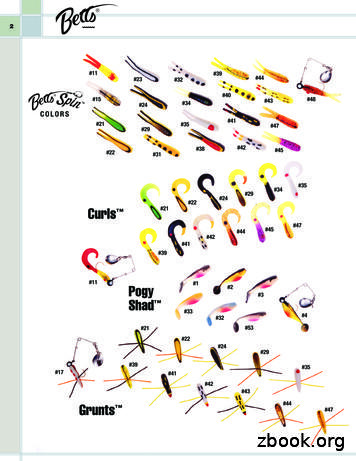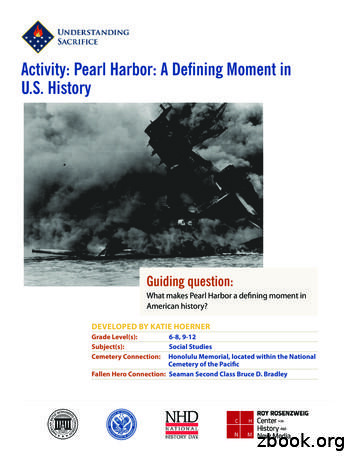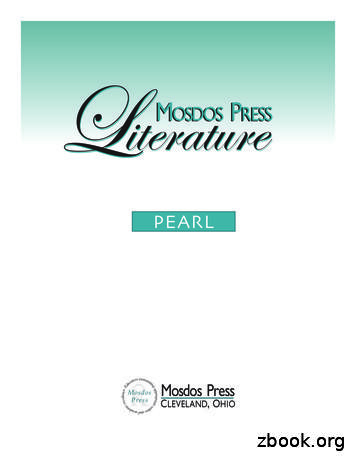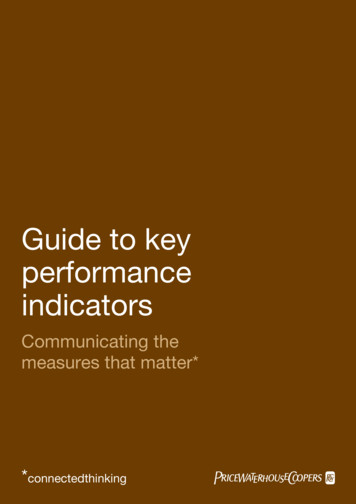Pearl Harbor Is Burning! - Pittsburgh Public Schools
Pearl Harbor Is Burning!by Kathleen V. KudlinskiIt is 1941. Frank Hopkins is miserable.He wishes his family never moved toHawaii. The island boys call him haoliand knock him down. But then Frankmeets Kenji, a Japanese Americanboy who loves baseball as much as hedoes. Could they be friends? As theyplay on Frank’s tree fort they witnessJapanese planes attack Pearl Harbor.With Frank’s parents needed elsewherefor the emergency, he stays overnightwith Kenji’s family. Their customs feelstrange to Frank at first, but he soonfeels safe and accepted there andknows that no matter what happenswith the war, he and Kenji will begood friends.Reading Level (Lexile) 490LFormat/Length Chapter book; 80 pagesPicture Support SomeLanguage Register Conversational, narrative, familiarContent Load HistoricalRelated Skills VocabularyContext Clues Comprehension and Critical ThinkingMain Idea and DetailsSequence Reading and Learning StrategiesParaphraseAbout the AuthorA former teacher, Kathleen Kudlinski continues to connect with children throughher writing and school visits. A lover of nature and history, she has writtenbiographies, science books, and historical fiction. As a student, she recalls howhistory was just an endless stream of facts. However, by creating the story part ofhistory for her novels, she began to care more deeply about the real people wholived through the events. Inspired by the anniversary of Pearl Harbor’s bombing,Pearl Harbor Is Burning! is just one of several of her stories based on historicalevents. Others are about a variety of topics including World War I, an earthquakein San Francisco, and a journey west on the Oregon Trail.page Hampton-Brown1 of 8
Pearl Harbor Is Burning!Think About What You KnowFriendship and Trust The friendship described in this storyis special because Kenji is part Japanese, a member of the sameculture that bombed Pearl Harbor. To help students understandthe war-time friendship: Explain: In 1939, Europe was at war. The United Statesjoined the war after the Japanese bombed Pearl Harbor inHawaii in 1941. Point out Hawaii and Pearl Harbor ona map. Then say: Hawaiians are from many different Asian andCaucasian cultures. They all work hard and live togetherpeacefully just like they did in 1941. At that time, Hawaiiwas a territory of the United States. Next, have students brainstorm what it might have beenlike in Hawaii during and after the bombing. Prompt withquestions such as How did the people feel when the harborwas bombed? Were they suspicious about their neighbors?Which ones? Was it fair not to trust them? Why or why not? Then students can use Student Journal, page 3 to name anddescribe a person they trust no matter what happens.Preview and PredictStudent Journal, page 3Have students look at the front cover, read the title, andthen read the summary on the back cover. Say: Kenji is a Japanese American. But, it’s the Japanesewho bomb Pearl Harbor. How did this make somepeople in Hawaii feel about Japanese Americans? Doyou think Frank will feel the same way?Prepare to ReadThink About What You KnowIf you trust someone, you believe that the person will always be truthful andfair. A person you trust will act in your best interest all the time, no matterwhat happens. Who do you trust? Why?Then point out The Exchange question on the title page:What makes a good friend? Explain that when they finishreading, they’ll share their ideas about this and otherquestions with a group.Next, have students complete Student Journal, page 3 topreview the book and make predictions about the eventsand the boys’ friendship.As students page through the book, identify the storyas historical fiction: a story based on facts with made-upcharacters. Point out pages 74–76 and explain that theauthor included the pages to tell readers which eventsreally happened.page Hampton-Brown2 of 8Preview and Predict Look at the front cover. Read the summary on the back cover. Read The Exchange question on the title page.1. Page through the book and look at the pictures and chapter names.What is this story mostly about?2. Do you think the war will stop Frank and Kenji from becoming friends?Why or why not?HP LL SJ A3 1.indd 36/15/05 9:34:31 PM
Pearl Harbor Is Burning!Use a Reading StrategyVenn Diagram Preview the graphic organizer on StudentJournal, page 4 with students. Explain that as they read PearlHarbor Is Burning!, they can complete the Venn Diagram tocompare Frank and Kenji. Have students add to their VennDiagrams after they finish reading each section.Student Journal, page 4Use a Reading StrategyUse a Venn DiagramAs you read Pearl Harbor Is Burning!, use a Venn Diagram to compare andcontrast Frank and Kenji.FrankBothAmerican from mainlandAmericanate ham and biscuitsfor breakfastloved baseballwanted to helpcommunity afterbombingslept on a bed; atewith a forkwere surprised byand scared ofthe bombinghelped at schoolafter the bombingwere curious andwent outside tosee the blackoutpageKenjiJapanese Americanfrom Hawaiiate rice balls forbreakfastwanted to go tohis family afterthe bombingslept on a futon;ate with chopsticks3 of 8 Hampton-BrownHP LL SJ A3 1.indd 46/16/05 11:27:28 PM
Pearl Harbor Is Burning!Read the BookForm the group that will read Pearl Harbor Is Burning!. Plan howthe group will read and respond. Some options are: Read with a Group Group members read an agreed-uponnumber of pages, complete the corresponding Student Journalpage(s), and meet to discuss. When they finish the book, theymeet again for The Exchange. The group can use the planneron Student Journal, page 2 to establish meeting times. Read Independently Group members read the book ontheir own and then meet for The Exchange. The group canuse the planner on Student Journal, page 2 to establish themeeting time. Guided Reading Read aloud the summary at the beginningof each chapter to give students an overview of the chapter.Use the Before You Move On questions to check comprehensionas students read. Use Look Ahead to set a focus for readingthe next set of pages. At the end of each section, assign theappropriate Student Journal page. Discuss the page beforestarting the next section. Establish a date for The Exchange andrecord it on the planner.Whichever option you choose, use pages 5–7 for an at-a-glanceview of Student Journal pages, as well as answers to theBefore You Move On questions.Student Journal, page 2Plan Your ScheduleMy group members are:We plan to read Pearl Harbor Is Burning! and meet on these dates:ChaptersDate We Will Finish ReadingDate We Will DiscussAloha, DummyIsland BoyAttack!The RaceChopsticksAir RaidAbout this BookOur Exchange meeting will be on this date:page Hampton-Brown4 of 8HP LL SJ A3 1.indd 2.6/15/05 9:34:31 PM
Pearl Harbor Is Burning!Student Journal, page 5Pages 7–26Chapters 1– 2Chapters 1–2: Pages 7–26Respond to Aloha, Dummy andIsland BoyANSWERS TO “BEFORE YOU MOVE ON”Venn DiagramPAGE 161. Conflict The story started with a problem. What was it?Island boys were mean to Frank because he was a newcomer anddifferent from them.2. Inference Why did Frank think that Kenji was not American?Because he’s Japanese and looks different from him.Review what has happened in the story so far. Start a Venn Diagram onJournal page 4 that compares and contrasts Frank and Kenji.Think It OverThink about what you have read so far and answer these questions.1. Personal Response Frank and Kenji were alike because they bothliked baseball. How are you similar to your friends?PAGE 261. Conflict Weston and Frank did not become goodfriends. Why?Because they had different interests.2. Character How can you tell that Frank’s mom did not trustpeople who were not like her?Because she questioned Frank about Kenji, wanted him to play withkids like Weston, and didn’t want him to be like a native.2. Opinion Do you think that Frank gave Weston a fair chance at beinghis friend? Why or why not?3. Character’s Motive Why do you think Kenji decided to be friendly toFrank? What does this tell you about Kenji?Kenji was a nice person. He did not mind that Frank wasnot an island boy. Kenji might have liked mainland thingsa lot, like baseball. He felt sorry for Frank.Pages 27–39Chapter 3HP LL SJ A3 1.indd 56/15/05 9:34:31 PMANSWERS TO “BEFORE YOU MOVE ON”PAGE 311. Character Did it seem like Frank and Kenji would be friends?How did you know?Yes, because they shared food, Frank gave the rice balls a chanceeven though they tasted strange at first, they had fun playing ball,they seemed comfortable together.2. Plot Reread pages 30 and 31. How can you tell a war wasstarting?Navy fleet in harbor; air raidsStudent Journal, page 6Chapter 3: Pages 27–39Respond to Attack!Venn DiagramAdd to your Venn Diagram on Journal page 4 to show more ways thatFrank and Kenji were alike and different.Think It OverWrite the answers to these questions.1. Personal Response What do you think it was like to be JapaneseAmerican during the war between Japan and America?PAGE 391. Conclusions Reread page 34. What showed you that Frankand Kenji were surprised by the bombing?They screamed, Frank thought it couldn’t be real, they criedand yelled.2. Cause and Effect Reread page 35. What happened that madeKenji and Frank cheer?The United States started fighting back.page Hampton-Brown5 of 82. Paraphrase Reread page 28. What is Pidgin English? Why did some peoplein Hawaii speak it?a form of English that includes words from manylanguages, created so people coming from many placescould understand each other; probably used in Hawaiibecause there were people from all over the world livingthere3. Sequence Read pages 32–39. List the order of events of the attack onPearl Harbor.The Japanese planes attacked. Air raid sirens screamed.Some battleships got hit. The attack ended. Then asecond attack began.HP LL SJ A3 1.indd 66/15/05 9:34:32 PM
Pearl Harbor Is Burning!Student Journal, page 7Pages 40–50Chapter 4Chapter 4: Pages 40–50Respond to The RaceANSWERS TO “BEFORE YOU MOVE ON”Venn DiagramReview what you just read and add more comparisons about Frank andKenji to your Venn Diagram on Journal page 4.PAGE 501. Character’s Motive The school was open to hold emergencymeetings. Why did Kenji not want to help at the schoolat first?Because he felt that his first duty was to his family.2. Character’s Point of View Reread page 49.What did Frank wish his mother would understand?that Kenji was just like him and was a good friendThink It OverWrite the answers to these questions.1. Personal Response Frank said it would have been awful to see thebombing without Kenji. Tell about a difficult time you were happy tohave a friend with you.2. Sequence What happened after the boys finished helping at the school?Why do you think that happened?The boys got stopped by a police officer. He asked whothey were and wrote their names down.Pages 51–63Chapter 53. Inference Why do you think the officer wrote the boys’ names down?Since Hawaii had just been bombed, the police werelooking for suspicious people and trying to keeppeople safe.ANSWERS TO “BEFORE YOU MOVE ON”PAGE 571. Comparisons Frank was surprised that the Imotos didn’t wearshoes in the house like his family. What else is different fromhis home?bowing to greet people, furnishings, language2. Character Why do you think Frank’s mother was relieved shecouldn’t stay at the Imotos’ house for tea?We know that Frank’s mother was wary of strangers, especiallyJapanese people. She probably didn’t want to spend time withthe Imotos.PAGE 631. Character Frank said that dinner was “loud and friendly” and“strange and delicious.” What does this show about Frank?He is the kind of person who enjoys new experiences and doesn’tjudge negatively.2. Conflict Reread page 62. Why did Mr. Imoto say “no moretalking in Japanese” and “no more Japanese flags”?Because he didn’t want Americans to think they supported theJapanese military.HP LL SJ A3 1.indd 76/15/05 9:34:32 PMStudent Journal, page 8Chapter 5: Pages 51–63Respond to ChopsticksVenn DiagramAdd to your Venn Diagram on Journal page 4.Think It OverWrite the answers to these questions.1. Personal Response Have you ever eaten food from a culture that wasdifferent from your own? If so, what was it like? If you have not,would you be willing to try?2. Context Clues Look at the word blackout on page 61. What words in thenext sentence help you understand the meaning of blackout?could use any lights for a targetThese words show that you would not want the lightson because it was dangerous. So you want no lights, or ablackout.3. Character’s Point of View Grandfather got upset when Mr. Imotosaid “no more Japanese.” How do you think Grandfather was feeling?He was probably angry because he wanted to practicehis traditions. He didn’t want to feel ashamed of beingJapanese. He didn’t support the Japanese in this war anddidn’t want Americans to assume he did.page Hampton-Brown6 of 8HP LL SJ A3 1.indd 86/15/05 9:34:32 PM
Pearl Harbor Is Burning!Student Journal, page 9Pages 64–76Chapter 6 and About This BookChapter 6: Pages 64–76Respond to Air Raid andAbout this BookANSWERS TO “BEFORE YOU MOVE ON”Venn DiagramPAGE 72Complete your Venn Diagram on Journal page 4.1. Cause and Effect Frank and Kenji went outside to see theblackout. Why was this so dangerous?It was wartime; soldiers had orders to shoot suspicious people; theboys could have been killed.2. Inference Reread page 72. How does Frank feel about Kenji?How do you know?Frank was thankful to have Kenji as a friend. He smiled, wanted toknow how to say friend in Japanese, and felt safe at his house.Think It OverWrite the answers to these questions.1. Personal Response How did the ending make you feel? Why?2. Context Clues Look at the word futons on page 64. What words in thenext two sentences help you understand the meaning of futons?straw mat, thick pad, blanketThese words describe a futon.PAGE 761. Author’s Point of View Did the author feel her book wasrealistic? Why or why not?Yes, because she talked to people who lived through the attacks.2. Cause and Effect What happened to many JapaneseAmericans after the bombings of Pearl Harbor?They were taken from their homes and put into prisons calledinternment camps.3. Author’s Purpose Why do you think the author chose to tell about theprison camps?She wanted to let the reader know about the mistakesof the past.HP LL SJ A3 1.indd 9page Hampton-Brown7 of 86/15/05 9:34:32 PM
Pearl Harbor Is Burning!Allow time for groups to meet for The Exchange. If you plan to participate, usethese tips for guiding students in discussing the big question:What makes a good friend?How would Frank answer this question? Think about why he gets upset withthe way his mother feels about Kenji.Frank would probably say that a good friend sticks up for you, has similar interests, andmakes you feel safe and happy.Although Frank and Kenji are different in many ways, they feel comfortabletogether. What does a friend do that makes you feel comfortable?In the end, we learn that Japanese Americans were put in prison camps afterthe war. How do you think Frank would feel if Kenji went to a prison camp?Have you ever seen a friend being mistreated? Were you able to help thefriend?Frank would probably feel that it was not fair because Kenji was an American and didn’tdo anything against his country. He would also miss Kenji and feel sad and lonely.Extend the ReadingWrite a letterGive a Radio ReportFriendship DebateInvite students to write aletter from Frank to a friendin Maryland describing thethings he learned from Kenji.Remind them that a friendlyletter has a heading with anaddress and date, greeting,body, closing, and signature.After students review pages27–39, have them turn thedescriptions into a radioscript to announce theevents to the people ofHonolulu. After rehearsal,students may want topresent their report tothe class.Frank’s father says“Sometimes the best kindof friends are the ones whoteach us new things.” Askgroups: Do you agree ordisagree that a best friendis one who teaches yousomething? Then have themdebate the issue.page Hampton-Brown8 of 8
culture that bombed Pearl Harbor. To help students understand the war-time friendship: Explain: In 1939, Europe was at war. The United States joined the war after the Japanese bombed Pearl Harbor in Hawaii in 1941. Point out Hawaii and Pearl Harbor on a map. Then say: Hawaii
Color Chart for #54 & #56 Series 1 Clear Glitter Tipped Tri Colors: 2 Yellow 4 Pink/Pearl 5 Red/Pearl 7 Yellow/Pearl 8 Green/Chart. 9 Chart. Glitter 10 Chartreuse 11 Red/Chart. 13 Blue/Cl. Glitter 14 Purple/Pearl 15 Black/Pearl 18 White/Chart. 19 Pearl 20 Blue/Pearl 21 Blue/Chart. 22 Blk./Chart. Glitter 23 Blk./Chart. 34-3 Blue/Pearl/Cl. Glitter
Activity: Pearl Harbor: A Defining Moment in U.S. History 4 Lesson Preparation Divide students into groups of three to four students per group. Make one copy of the Pearl Harbor Source Packet for each group of three to four students. Make one copy of the Pearl Harbor
base of the American Pacific Fleet at Pearl Harbor, on the Island of Oahu in what was then the territory of Hawaii (Hawaii did not become a state until 1959). Most Americans refer to the attack simply as "Pearl Harbor," and many historians regard it as one of the single most important e
THE HARBOR Paradise Bay, sometimes known as Beaver Harbor, St. James Harbor or simply "The Harbor," is a remarkable example of a natural, sheltered harbor. It is extremely popular with boaters, as is evidenced by the many public and private docks that dot its shores, as well as the many boats that pepper its waters throughout the summer months.
Sep 06, 2016 · Mosdos Press CLEVELAND, OHIO àxÜtàâÜxMOSDOSOSDOS PRESSRESS PEARL E d u c a t o r s trans m i t t i n g a p p r o p r i a t e v a l u e s a n d a c a d e m i c e x c e l l e n c e Mosdos Press 001-006 Pearl 6th:001-006 Pearl 6th 1/22/07 10:26 PM Page 1
Mr. Pearl and his son, Gary, who has served as . the President and CEO since 1998, have evolved Pearl Insurance into today's multifaceted Pearl Companies. Despite its tremendous growth, Pearl Insurance has remained committed to designing, administering, and marketing insurance programs for membership organizations, affinity groups, and .
Musik: Hans Zimmer PEARL HARBOR Arrangement: Patrik Wirth . PEARl HARBOR_CesFes_EZ Sopranflöte 1 in Ces Auth
a group level, or would be more usefully reported at business segment level. In some instances it may be more appropriate to report separately KPIs for each business segment if the process of aggregation renders the output meaningless. For example it is clearly more informative to report a retail business segment separately rather than combining it with a personal fi nancial services segment .























